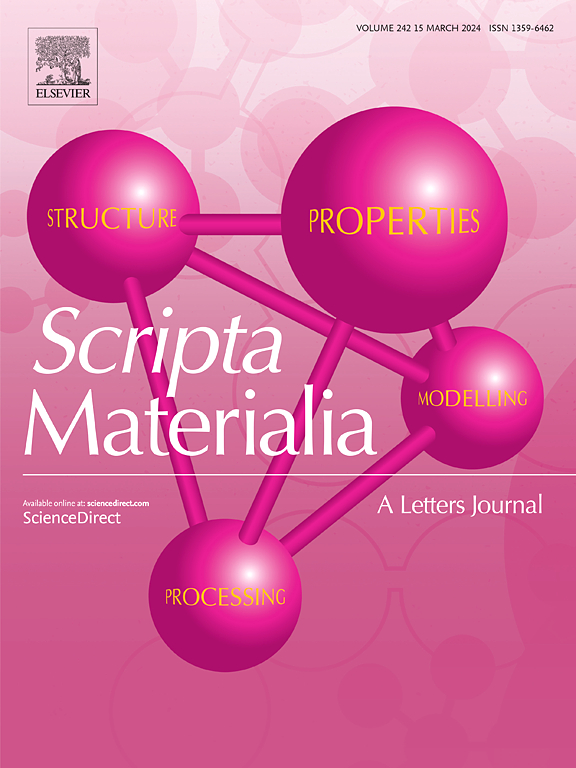Fe2VAl Heusler合金的表面位错:形成及其对电阻率的影响
IF 5.6
2区 材料科学
Q2 MATERIALS SCIENCE, MULTIDISCIPLINARY
引用次数: 0
摘要
位错密度影响材料的功能性能。对于硬材料,由于裂纹的形成,引入位错通常是具有挑战性的。在这里,我们使用机械研磨和纳米压痕技术在Fe2VAl中形成近表面位错。透射电镜显示,在距离表面1 μm处分别存在2 × 1014和3 × 1013 m-2。局部四点探针电测量表明,原始区域、凹陷区域和地面区域的电阻率分别为3.9、4.2和7.5±0.1 μΩ cm,证实位错显著阻碍电荷传输。从电子与位错引起的应变场相互作用的角度讨论了电阻率与位错密度之间的关系。此外,我们确定了原始合金的弹性模量和纳米硬度分别为225±5 GPa和6.6±0.1 GPa。该研究表明,表面机械处理可用于控制这些合金的电阻率。本文章由计算机程序翻译,如有差异,请以英文原文为准。

Surface dislocations in a Fe2VAl Heusler alloy: Formation and effects on electrical resistivity
Dislocation density impacts functional properties of materials. For hard materials, introducing dislocations is normally challenging due to crack formation. Here, we use mechanical grinding and nanoindentation techniques to form near-surface dislocations in Fe2VAl. Transmission electron microscopy shows that 2 × 1014 and 3 × 1013 m-2 are present at 1 μm away from the surface, respectively. Local four-point probe electrical measurements indicate that the electrical resistivities for pristine, indented, and ground regions are 3.9, 4.2, and 7.5 ± 0.1 μΩ cm, respectively, confirming that dislocations significantly impede charge transport. The relation between resistivity and dislocation density is discussed in terms of the interaction between electrons and the strain fields induced by dislocations. Additionally, we determine that the elastic modulus and nanohardness for the pristine alloy are 225 ± 5 GPa and 6.6 ± 0.1 GPa, respectively. This study demonstrates that surface mechanical treatments can be used to control the electrical resistivity of these alloys.
求助全文
通过发布文献求助,成功后即可免费获取论文全文。
去求助
来源期刊

Scripta Materialia
工程技术-材料科学:综合
CiteScore
11.40
自引率
5.00%
发文量
581
审稿时长
34 days
期刊介绍:
Scripta Materialia is a LETTERS journal of Acta Materialia, providing a forum for the rapid publication of short communications on the relationship between the structure and the properties of inorganic materials. The emphasis is on originality rather than incremental research. Short reports on the development of materials with novel or substantially improved properties are also welcomed. Emphasis is on either the functional or mechanical behavior of metals, ceramics and semiconductors at all length scales.
 求助内容:
求助内容: 应助结果提醒方式:
应助结果提醒方式:


